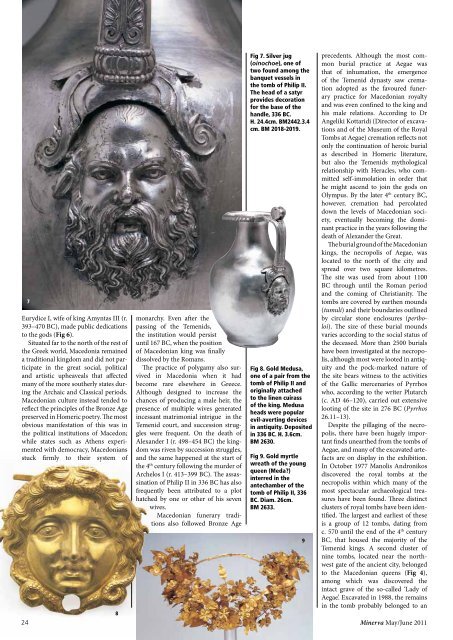Cult of beauty - Minerva
Cult of beauty - Minerva
Cult of beauty - Minerva
Create successful ePaper yourself
Turn your PDF publications into a flip-book with our unique Google optimized e-Paper software.
7<br />
Eurydice I, wife <strong>of</strong> king Amyntas III (r.<br />
393–470 BC), made public dedications<br />
to the gods (Fig 6).<br />
Situated far to the north <strong>of</strong> the rest <strong>of</strong><br />
the Greek world, Macedonia remained<br />
a traditional kingdom and did not participate<br />
in the great social, political<br />
and artistic upheaveals that affected<br />
many <strong>of</strong> the more southerly states during<br />
the Archaic and Classical periods.<br />
Macedonian culture instead tended to<br />
reflect the principles <strong>of</strong> the Bronze Age<br />
preserved in Homeric poetry. The most<br />
obvious manifestation <strong>of</strong> this was in<br />
the political institutions <strong>of</strong> Macedon;<br />
while states such as Athens experimented<br />
with democracy, Macedonians<br />
stuck firmly to their system <strong>of</strong><br />
24<br />
8<br />
monarchy. Even after the<br />
passing <strong>of</strong> the Temenids,<br />
the institution would persist<br />
until 167 BC, when the position<br />
<strong>of</strong> Macedonian king was finally<br />
dissolved by the Romans.<br />
The practice <strong>of</strong> polygamy also survived<br />
in Macedonia when it had<br />
become rare elsewhere in Greece.<br />
Although designed to increase the<br />
chances <strong>of</strong> producing a male heir, the<br />
presence <strong>of</strong> multiple wives generated<br />
incessant matrimonial intrigue in the<br />
Temenid court, and succession struggles<br />
were frequent. On the death <strong>of</strong><br />
Alexander I (r. 498–454 BC) the kingdom<br />
was riven by succession struggles,<br />
and the same happened at the start <strong>of</strong><br />
the 4 th century following the murder <strong>of</strong><br />
Archelos I (r. 413–399 BC). The assassination<br />
<strong>of</strong> Philip II in 336 BC has also<br />
frequently been attributed to a plot<br />
hatched by one or other <strong>of</strong> his seven<br />
wives.<br />
Macedonian funerary traditions<br />
also followed Bronze Age<br />
Fig 7. Silver jug<br />
(oinochoe), one <strong>of</strong><br />
two found among the<br />
banquet vessels in<br />
the tomb <strong>of</strong> Philip II.<br />
The head <strong>of</strong> a satyr<br />
provides decoration<br />
for the base <strong>of</strong> the<br />
handle, 336 BC.<br />
H. 24.4cm. BM2442.3.4<br />
cm. BM 2018-2019.<br />
Fig 8. Gold Medusa,<br />
one <strong>of</strong> a pair from the<br />
tomb <strong>of</strong> Philip II and<br />
originally attached<br />
to the linen cuirass<br />
<strong>of</strong> the king. Medusa<br />
heads were popular<br />
evil-averting devices<br />
in antiquity. Deposited<br />
in 336 BC. H. 3.6cm.<br />
BM 2630.<br />
Fig 9. Gold myrtle<br />
wreath <strong>of</strong> the young<br />
queen (Meda?)<br />
interred in the<br />
antechamber <strong>of</strong> the<br />
tomb <strong>of</strong> Philip II, 336<br />
BC. Diam. 26cm.<br />
BM 2633.<br />
9<br />
precedents. Although the most common<br />
burial practice at Aegae was<br />
that <strong>of</strong> inhumation, the emergence<br />
<strong>of</strong> the Temenid dynasty saw cremation<br />
adopted as the favoured funerary<br />
practice for Macedonian royalty<br />
and was even confined to the king and<br />
his male relations. According to Dr<br />
Angeliki Kottaridi (Director <strong>of</strong> excavations<br />
and <strong>of</strong> the Museum <strong>of</strong> the Royal<br />
Tombs at Aegae) cremation reflects not<br />
only the continuation <strong>of</strong> heroic burial<br />
as described in Homeric literature,<br />
but also the Temenids mythological<br />
relationship with Heracles, who committed<br />
self-immolation in order that<br />
he might ascend to join the gods on<br />
Olympus. By the later 4 th century BC,<br />
however, cremation had percolated<br />
down the levels <strong>of</strong> Macedonian society,<br />
eventually becoming the dominant<br />
practice in the years following the<br />
death <strong>of</strong> Alexander the Great.<br />
The burial ground <strong>of</strong> the Macedonian<br />
kings, the necropolis <strong>of</strong> Aegae, was<br />
located to the north <strong>of</strong> the city and<br />
spread over two square kilometres.<br />
The site was used from about 1100<br />
BC through until the Roman period<br />
and the coming <strong>of</strong> Christianity. The<br />
tombs are covered by earthen mounds<br />
(tumuli) and their boundaries outlined<br />
by circular stone enclosures (periboloi).<br />
The size <strong>of</strong> these burial mounds<br />
varies according to the social status <strong>of</strong><br />
the deceased. More than 2500 burials<br />
have been investigated at the necropolis,<br />
although most were looted in antiquity<br />
and the pock-marked nature <strong>of</strong><br />
the site bears witness to the activities<br />
<strong>of</strong> the Gallic mercenaries <strong>of</strong> Pyrrhos<br />
who, according to the writer Plutarch<br />
(c. AD 46–120), carried out extensive<br />
looting <strong>of</strong> the site in 276 BC (Pyrrhos<br />
26.11–13).<br />
Despite the pillaging <strong>of</strong> the necropolis,<br />
there have been hugely important<br />
finds unearthed from the tombs <strong>of</strong><br />
Aegae, and many <strong>of</strong> the excavated artefacts<br />
are on display in the exhibition.<br />
In October 1977 Manolis Andronikos<br />
discovered the royal tombs at the<br />
necropolis within which many <strong>of</strong> the<br />
most spectacular archaeological treasures<br />
have been found. Three distinct<br />
clusters <strong>of</strong> royal tombs have been identified.<br />
The largest and earliest <strong>of</strong> these<br />
is a group <strong>of</strong> 12 tombs, dating from<br />
c. 570 until the end <strong>of</strong> the 4 th century<br />
BC, that housed the majority <strong>of</strong> the<br />
Temenid kings. A second cluster <strong>of</strong><br />
nine tombs, located near the northwest<br />
gate <strong>of</strong> the ancient city, belonged<br />
to the Macedonian queens (Fig 4),<br />
among which was discovered the<br />
intact grave <strong>of</strong> the so-called ‘Lady <strong>of</strong><br />
Aegae’. Excavated in 1988, the remains<br />
in the tomb probably belonged to an<br />
<strong>Minerva</strong> May/June 2011

















